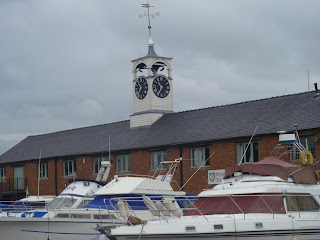The Hatherton Branch
The canal once linked the Staffs & Worces canal to the Cannock Extension Canal, thereby making a connection into Birmingham. The canal was used for coal traffic and was very profitable, and the canal remained in use until 1949. It was formally abandoned in 1955, after which the Churchbridge flight and much of the Extension Canal were destroyed by open cast mining. The Lichfield and Hatherton Canals Restoration Trust was formed in 1989 with a view to restoring the canal. Since then they have worked hard to protect and restore the canal, which was threatened by the route of the M6 Toll motorway. Negotiations eventually led to the provision of two culverts, one paid for by the Trust and the other by the road builders, which will be used in due course for the route of the re-aligned canal. But for now, only the first lock off the Staffs & Worcs canal is operational, and we had the opportunity to do this little used lock.
At the end of the basin can just be seen the remains of the second lock, which is now used as a dry dock by the boatyard.
Unusually there is only one paddle for the bottom gates (most locks have at least 2).
 |
| One of 2 top ground paddles. The mechanism for stopping the lock paddle dropping is to insert a thin piece of metal attached to the lock by a chain. |
The Staffs & Worcs Canal
It runs for 46 miles from the River Severn at Stourport in Worcestershire to the Trent and Mersey Canal at Haywood Junction by Great Haywood, although we were only doing it from Calf Heath, passed Autherley Junction, and then down to Stourport. One odd little feature of this canal are the faces in the trees. Someone has gone to considerable time and effort to produce these.
Also the side weirs are a little different.
This canal also has quite picturesque locks (despite BW's attempts to deface the locks in the name of Health & Safety).
The Bratch Locks are a noted feature of this Canal, planned by James Brindley, and opened in 1772 as a three lock staircase. They were later re-engineered as three separate locks (there is now space between the locks of about 2 feet).
They are served by two bridges, a toll house,
and a keeper's cottage.
The whole forms a well-preserved example of vernacular Georgian architecture and design, built of mellow local brick. These days a lock keeper ensures the movement of boats letting 3 down then 3 up - but this does mean delays are possible here, especially if you are boat 4 (which we were).
A few miles on from Bratch is the village of Kinver, in south Staffordshire. There are notable rock or cave houses on Kinver Edge, carved from the sandstone, some inhabited as late as the 1960s. Some of the rock houses have been restored to their former inhabited states.
The sandstone landscape is also evident at some of the locks.
These caves were used for sheltering horses overnight.
From Kinver the canal twists through the countryside and then goes through Kiddeminster.
And finally the canal reaches Stourport on Seven - which is a pleasant town, equipped with its own fun fair, as well as one of the best butchers we've ever been to, who stocks anything that walks, crawls, flies or swims. Stourport also has 4 basins, dominated by a clock tower.
On the 6th August we went down the 2 sets of 2 lock staircases and onto the River Seven.
The trip on the River Seven, well you'll just have to read the next instalment for the tale of that drama!

















No comments:
Post a Comment